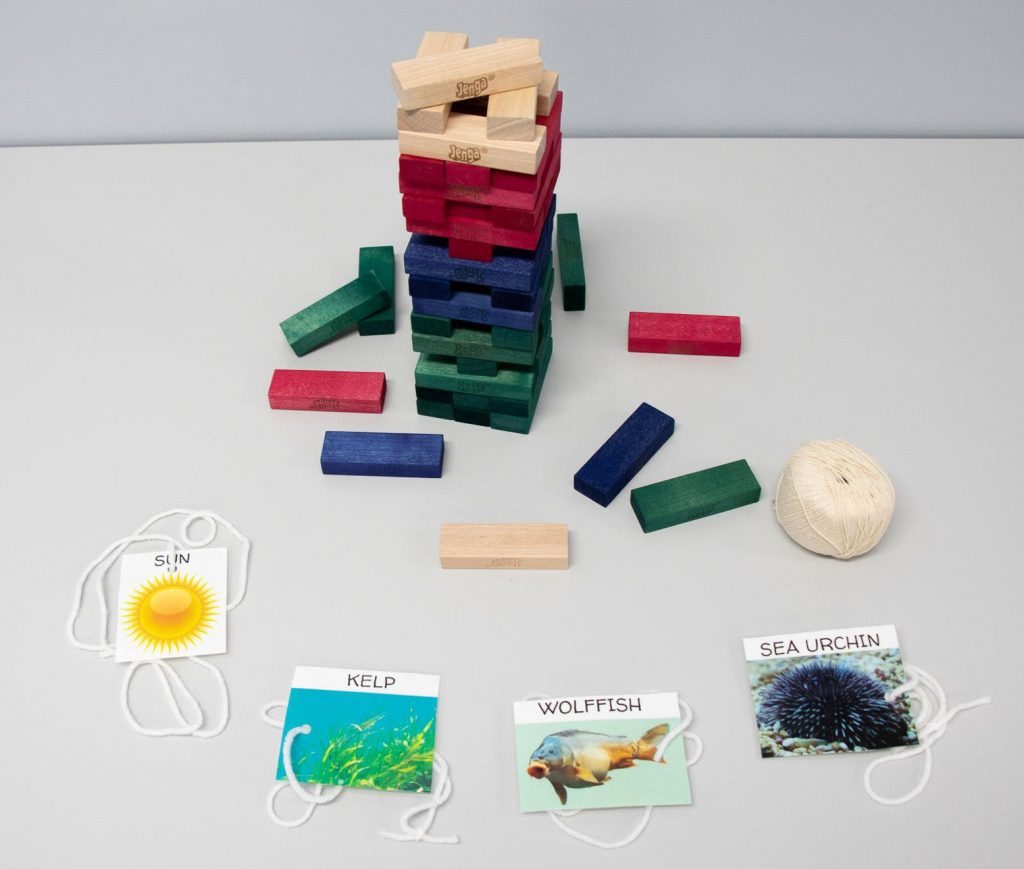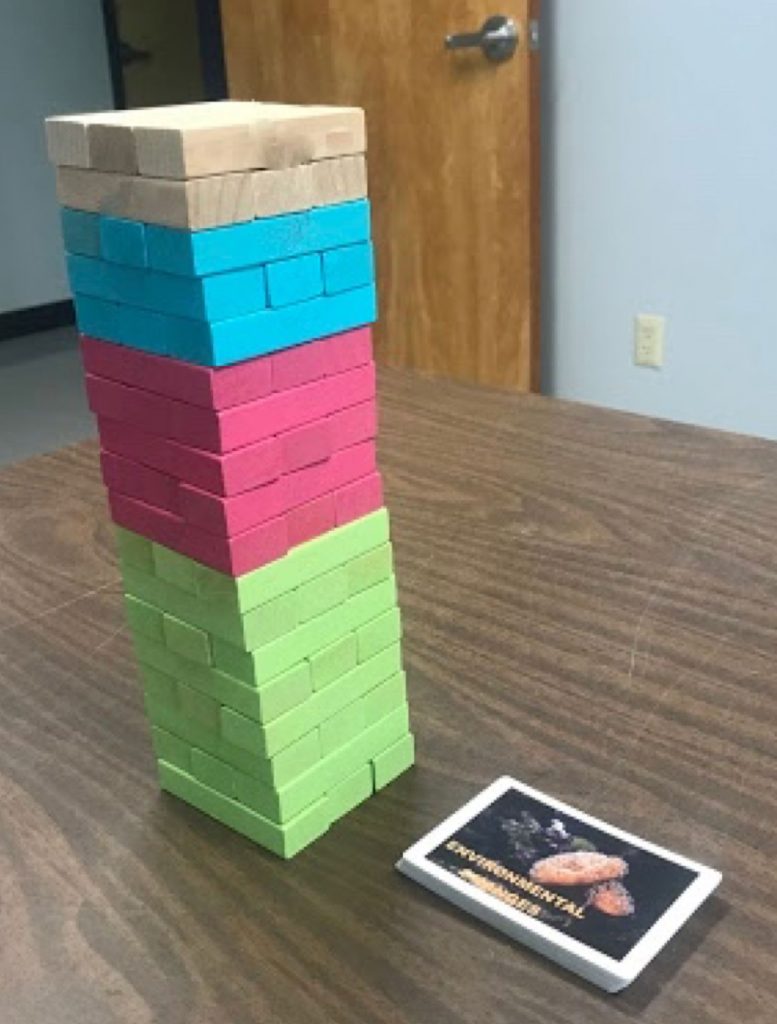Activity 1: Kelp Forest Towers
Learning Targets
- Understand the role of kelp, urchins, and wolffish in the New England ecosystem.
- Understand how a population of one organism can affect the population of another in the same food web.
- Model human impacts on a fragile food web.
Time to complete activity: 45-60 minutes
Background for facilitator
Note: All links are provided purely for educational purposes. No responsibility is assumed for any content on the linked site(s).
The waters of New England are home to abundant and diverse kelp forests, where large species of kelp provide habitat for countless marine organisms. The Atlantic wolffish is an important resident of the kelp beds. They prey upon sea urchins that graze upon the kelp. Wolffish protect kelp from predation and allow kelp forests to flourish, which is good news for that fragile marine ecosystem.
The loss of a predator, such as the Atlantic wolffish, would result in an increase of herbivores (urchins, in this case), which leads to a decrease in the abundance of kelp that provides habitat for many species in New England waters. Protecting important predators will build resilience for our ecosystems in more ways than we can count. For more information, visit Stewarding the Ecosystem.
Vocabulary List
- Herbivores: an animal that eats only plants
- Kelp: a large brown algae seaweed
Key concepts to address throughout this activity
- Small changes can set off a chain of reactions that can affect an entire ecosystem.
- Organisms in an ecosystem depend on each other in many ways.
- Humans can negatively or positively impact the food web.
Materials
- 1 set of Web of Life necklaces:
- 2 Wolffish
- 5 Sea Urchins
- 7 Kelp
- 1 Sun
- 1 ball of twine
- 5 sets of stacking blocks:
- 24 Green blocks (kelp)
- 15 Pink blocks (urchin)
- 9 Blue blocks (wolffish)
- 6 Uncolored blocks (ocean surface)
- 5 decks of “Environmental Changes” cards
- 5-10 Dry-Erase markers
Setup

Methods
Engage
- Begin by asking the youth to stand up and spread out in a circle.
- You will each be playing the role of an important organism in the waters of New England.
- Distribute the sun, kelp, urchin, and wolffish necklaces randomly among the circle until each youth has their own. *Note: if you have more than 15 youth, they will need to work in pairs.
- Explain this particular food chain:
- In this marine ecosystem, there are KELPS, SEA URCHINS, WOLFFISH, and the SUN.
- Raise your hand if you are a Kelp.
- Raise your hand if you are a Sea Urchin.
- Raise your hand if you are a Wolffish.
- Raise your hand if you are the Sun.
- Ask youth to recall any information they know about energy transfer:
- Raise your hand if you get your energy from the sun.
- The Kelps should raise their hands.
- Raise your hand if you get energy from eating another creature.
- The Urchins and Wolffish should raise their hands.
- Raise your hand if you get your energy from the sun.
- Explain the relationships between the organisms in this ecosystem:
- In this ecosystem, Kelp gets its energy from the sun;
- Kelp is eaten by the Sea Urchins;
- Sea Urchins are eaten by the Wolffish.
- We are going to model these connections using a ball of twine.
Explore
- Pass the ball of twine to the “Sun” to begin the web of life and demonstrate the first connections:
- The Sun begins by holding the end of this twine — the Sun should not drop this end. Hold on to it for the entire game!
- Since the Sun provides Kelp with energy, they are connected.
- Let’s demonstrate this connection by having the Sun pass the ball of twine to a Kelp, but not letting go of the end of the twine.
- Now that a Kelp has the ball, you can see that these two things are connected in the ecosystem.
- What is Kelp connected to?
- SEA URCHINS (eat kelp) and SUN (provides energy for photosynthesis).
- The Kelp can pass the string to anything that it is connected to.
- Have the Kelp pass the string to a Sea Urchin for this demo.
- Now that a Sea Urchin has the ball, you can see how these three things are connected to each other.
- What are Sea Urchins connected to?
- WOLFFISH (eat urchins) and KELP (is food for sea urchins).
- The Sea Urchin can pass the string to anything that it is connected to.
- Have the Sea Urchin pass the string to a Wolffish for this demo.
- Now that the Wolffish has the ball, you can see how all of these things are connected to each other.
- Direct the youth to keep passing the ball of twine until everyone in the circle is holding a piece of it.
- You may pass the twine to any organisms that you are connected to, whether you get your energy from them, or they get it from you.
- Be sure to pass the twine to someone who hasn’t had it yet.
- Be sure to hold on to your end of the twine before you pass the ball!
- When the twine has been passed to everyone, there will be a large “Web of Life”.
- Take the opportunity to emphasize how every organism in an ecosystem is connected to each other.
- What do you notice about this ecosystem?
- What would happen to the food web if we removed one of these organisms?
- Demonstrate a “stress” on the food web by asking 1-2 volunteers to take a few steps back while everyone else stays in place. Make sure everyone holds on to their twine.
- Who felt a tug on their twine?
- This represents how each organism is connected to each other in an ecosystem.
- Explain to the youth that they will be playing a game that demonstrates these connections between organisms in the kelp forest.
Explain
- Explain to the youth that they will be playing a tower building game.
- This game is all about how small changes can impact the stability of a whole ecosystem.
- The system is made up of organisms and their habitat, and all of the parts depend on each other.
- Introduce any unfamiliar vocabulary at this time to ensure understanding of the terminology used on the cards.
- Divide the youth into 5 cooperative learning groups of 3-4.
- Distribute a set of blocks to each group.
- Ask each group to set up the game by placing three green blocks side by side. Continue alternating layers of green blocks in a crisscross fashion. Once the green blocks are used up, stack the pink blocks, then the blue blocks, then the uncolored blocks until they are all stacked up in crisscrossed layers of three.
- Remind everyone to listen carefully as you read the rules aloud.
Game setup

Game Rules
- The first player picks a card, reads all of the information aloud and follows the instructions in the same order in which they are written on the card. For example, if the card says “Remove 1 kelp block, Add 2 urchin blocks”; the player must first remove 1 kelp block (green), and then add 2 urchin blocks (pink) if available to stack. They place the card into a discard pile when they are finished.
- Only the block being removed or returned may be touched. Holding the tower together while removing blocks is not allowed.
- The player may touch a block to see if it is loose before removing it, but must return the block to the original position if he/she chooses to remove another one instead.
- Players may only use one hand to remove and place the blocks.
- When a block is removed from the tower, it must be placed in a discard pile. *Note: the removed block does NOT get placed on the top of the tower.
- When a block is added to the tower, it must be placed on the same level it came from (Kelp [green] on the bottom, Urchins [pink] in the middle, Wolffish [blue] on the top).
- The unpainted blocks are not to be removed from the tower; they are only there to represent the ocean “surface.”
- If a player cannot go on their turn (for example, if the card says to add 2 kelp blocks, but there is only 1 kelp in the pile), then that player must hold on to that card, skip their turn, and try to play the card when it is their turn again.
- Play a practice or demonstration round to ensure that each group understands the rules.
- Shuffle the playing cards and stack them with the photos facing up.
- Continue taking turns until the tower falls and the ecosystem collapses.
- If the tower is still standing and the players have used up all of the cards, reshuffle the discard pile and keep playing until the tower falls.
Elaborate
- Instruct each group to set up their tower to play on their own as many times as desired.
- Be sure to encourage youth to read each card aloud, and to think about the consequences of the environmental change described on the card.
- Walk around to each group while they play the game to clarify questions and ensure the youth are following the rules.
Evaluate
- Engage the youth in a discussion of their experience:
- If the ocean is so large, why do small changes make a difference?
- In what ways did the organisms in this food web depend on each other?
- What surprised you when playing the game?
- What role do you think humans play in this food web?
Extension Ideas
- Play the game again with 1-4 blocks added for humans.

 This activity is supported by National Science Foundation award #EPS-0904155 to Maine EPSCoR at the University of Maine.
This activity is supported by National Science Foundation award #EPS-0904155 to Maine EPSCoR at the University of Maine.
